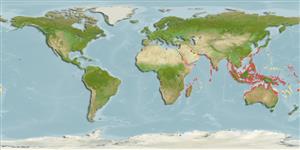Common names from other countries
>
Gobiiformes (Gobies) >
Gobiidae (Gobies) > Gobiinae
Etymology: Glossogobius: Greek, glossa = tongue + Latin, gobius = gudgeon (Ref. 45335).
More on author: Hamilton.
Environment: milieu / climate zone / depth range / distribution range
экология
морской; пресноводный; солоноватоводный донно-пелагический; амфидромный (Ref. 51243); пределы глубины 0 - 5 m (Ref. 86942). Tropical; 25°C - ? (Ref. 2059); 30°N - 32°S, 25°E - 176°E
Africa to Oceania: Red Sea and East Africa, south to Transkei in South Africa, and most inland freshwater bodies over the Indian Ocean and western Pacific (Ref. 4343, 52193). Common in coastal and estuarine waters from austral Africa and Madagascar to India and south of China.
Length at first maturity / Size / Вес / Возраст
Maturity: Lm ?, range 9 - ? cm
Max length : 50.0 cm SL самец/пол неопределен; (Ref. 4967); common length : 11.3 cm SL самец/пол неопределен; (Ref. 35840)
колючие лучи спинного плавника (общее число) : 7; членистые (мягкие) лучи спинного плавника (общее число) : 8 - 9; колючие лучи анального плавника: 1; членистые (мягкие) лучи анального плавника: 8 - 9.
Found mainly in freshwater and estuaries, but also enter the sea (Ref. 4833). Also occur in canals, ditches and ponds (Ref. 12693). Found in clear to turbid streams with rock, gravel or sand bottoms (Ref. 2847). Encountered in medium to large-sized rivers of the lower Mekong (Ref. 12975). Feed on small insects, crustaceans and small fish. Grow to a much larger size in brackish water than in fresh water. Marketed fresh (Ref. 12693). Cannibalism is relatively common for this species (Ref. 48660).
Life cycle and mating behavior
Maturities | размножение | Spawnings | Egg(s) | Fecundities | личинки
Spawning occurs in freshwater afterwhich eggs and larvae are washed down by the river current into the sea (Ref. 110258).
Maugé, L.A., 1986. Gobiidae. p. 358-388. In J. Daget, J.-P. Gosse and D.F.E. Thys van den Audenaerde (eds.) Check-list of the freshwater fishes of Africa (CLOFFA). ISNB, Brussels; MRAC, Tervuren; and ORSTOM, Paris. Vol. 2. (Ref. 4343)
Статус Красного Списка МСОП (Ref. 130435)
CITES (Ref. 128078)
Not Evaluated
Угроза для людей
Harmless
Использование человеком
рыболовство: не имеет хозяйственного значения; аквакультура (рыбоводство): коммерческий; аквариум: коммерческий
дополнительная информация
инструменты
Специальные отчеты
Скачать в формате XML
ресурсы в Интернет
Estimates based on models
Preferred temperature (Ref.
115969): 25 - 29.3, mean 28.5 (based on 2836 cells).
Phylogenetic diversity index (Ref.
82804): PD
50 = 0.5000 [Uniqueness, from 0.5 = low to 2.0 = high].
Bayesian length-weight: a=0.00724 (0.00642 - 0.00818), b=3.07 (3.04 - 3.10), in cm Total Length, based on LWR estimates for this species (Ref.
93245).
Trophic level (Ref.
69278): 3.7 ±0.2 se; based on diet studies.
устойчивость к внешним воздействиям (Ref.
120179): высокий, минимальное время удвоения популяции до 15 месяцев (K=0.8; Fec=18,578;).
Fishing Vulnerability (Ref.
59153): Low to moderate vulnerability (26 of 100).
